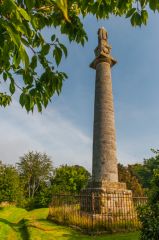
The National Trust for Scotland calls Hugh Miller (1802-1856) a 'polymath'; someone who is an acknowledged expert in a number of different fields. That description certainly applies to Miller, who was one of the most remarkable men in 19th century Scotland. From humble beginnings in this simple thatched cottage in Cromarty, he went on to become a self-taught expert in geology, influential newspaper editor, social reformer, folklorist, and political and religious commentator.
At the age of 17, Miller was apprenticed to a stonemason, and his work with quarrying local stone led him to study the geology of Cromarty. In 1829, at the age of 27, he published a collection of poems. This was followed by more works of poetry and by a series of books on geology, including The Old Red Sandstone (1841).
The phrase 'old red sandstone' is still used in geology today to describe a form of sedimentary rock. Miller was a devout Christian, and in 1840 he became editor of The Witness, the Edinburgh-based newspaper which acted as the voice of the popular party in the Church of Scotland. His views on evolution and Divine Mind might make for difficult reading today, but one outcome of his religious beliefs was that he became a champion of social, religious, and political reform.

His sudden death shocked Miller's contemporaries, and his funeral procession in Edinburgh drew huge crowds, a testament to his influence and appeal.
Our Visit
There are really two parts to visiting Hugh Miller's Birthplace; there is the single-storey thatched cottage where he was born and the lovely Georgian-style house beside it where you can explore a museum of his life and work. Behind the cottage is a lovely garden, where you will find a beautifully carved pedestal sundial crafted by Miller for his wife Lydia. To the rear of the museum is a small courtyard themed with sculptures representing Miller's work with fossils and the geology of Cromarty.
The Museum
Displays over three floors of the Georgian house cover every aspect of Miller's work - and that's a lot of ground to cover, for Miller was remarkably active in several fields. You can examine fossils that Miller found locally, along with the tools he used in his explorations, plus his written notes on the fossils. Miller's mason's tools are on display, his manuscripts, and an exhibit covering his influential career as editor of The Witness in Edinburgh. It is impossible to view the exhibit and not come away marvelling at how much Miller packed into his short life, and what an influence he had on his contemporaries.
The Birthplace Cottage
The attractive thatched cottage where Miller was born seems like the baby sibling of the larger museum beside it, but it is here that you really get a glimpse into just how humble Miller's origins were, and how remarkable was his rise to prominence in scholarly and literary circles. There is a simple parlour, kitchen and hearth, and a small bedroom area, simply furnished in the style of the early 19th century. Outside the low entrance is a cobbled yard, used as a working area, and steps leading to the small garden at the rear.
Do take a moment to follow the signposted trail that leads to Hugh Miller's memorial beside the burial ground at the top of the hill overlooking Cromarty. It should take no more than 5 minutes from the birthplace museum. The monument is a very classical design, with a statue of Miller atop a neoclassical column, rather like Admiral Nelson atop his column in Trafalgar Square in London. What really struck me about the memorial is how it emphasised the exceptional regard that Miller was held in by his countrymen. Such a grand memorial speaks volumes for his cultural influence and the legacy of his life and work.












